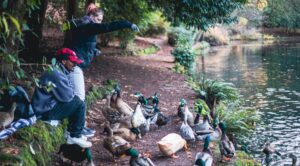Where to Sled, Snowshoe, and Play in the Snow in Oregon

Named after an early advocate for the sno-park system, Ray Benson Sno-Park has access to tons of ski and snowmobile trails in both the Willamette and the Deschutes National Forests.
If the Forecast is to be believed, we’re in for a cooler-than-average, snowier-than-normal winter in Oregon. Skiers, snowshoers, and sledders, rejoice! But not before picking up an Oregon sno-park permit, required at designated parking areas from November 1 through April 30—lest you want to get hit with a $30 fine.
Introduced in 1977 (when the fine for not displaying a permit was just $10), Oregon’s sno-park permit system raises funds that go to plowing lots for public recreational use. The state started with 64 designated winter-recreation parking areas and now counts 100, which vary in size, amenities, and activities available. Some offer little more than a plowed parking area and a good-looking hill, while others feature warming huts, shelters, maintained trails, and more.
Sno-park permit details
-
Permits are available online, at any Oregon DMV office, and by permit agents at resorts, retail shops, and sporting goods stores.
- Cost is $4 for a one-day permit, $9 for three-day, and $25 for a year, though nongovernment vendors can also charge a service fee.
- Permits can be moved from one vehicle to another.
- Sno-park permits issued in California and Idaho are honored in Oregon, and Oregon permits are honored in those states. (Washington has a different system.)
For a full list of all sno-parks in Oregon Sno-Parks, click here. Below are a few of our favorites.

Sledding is the main attraction at White River West Sno-Park.
For a reliable standby
Everyone’s first stop, White River West Sno-Park in Mt. Hood National Forest has the advantage of a giant parking lot. (It fills up with cheerful tailgaters on snowy and/or bluebird winter weekends, but there’s spillover parking at White River East, across the way.) The main attraction here is the sledding hill that faces away from the namesake river. Usually, families prescient enough to bring snow shovels have dug out fun obstacle courses in the snow. Snowshoers and cross-country skiers might prefer to tromp past the sledding hill and up into the backcountry canyon that rises from the north end, with the river on your right. Two miles in gets you great views of the mountain, and a good turnaround spot.
For super-snowy years
About 25 miles south of Hood River (and nine miles north of White River) on OR 35, Little John Sno-Park is best avoided in low-snow years, due to its lower elevation. But this year it’s open for business. The best thing about this location: the warming hut, complete with a firepit, a common amenity around the Central Cascades but in much shorter supply in the Mt. Hood National Forest. However, there’s a price to pay: Only snow tubes and plastic sledding disks are allowed here, so leave that old-school Fearless Flyer at home.
For smug snowshoers
At first blush, the Frog Lake Sno-Park seems unpromising for those seeking winter solitude, given the buzz of snowmobiles revving their engines in the parking lot. Not to worry: The snowmobilers are headed off to the namesake Frog Lake, to the right. Cross-country skiers and especially snowshoers are headed off to the Twin Lakes trail at left. Skiers may struggle with the hilly terrain and want to stop at Lower Twin Lake. Hardy snowshoers, however, can keep going to Upper Twin Lake for a peekaboo view of Mount Hood. It’s six miles round trip if you make it all the way to Upper Twin Lake.
For cross-country skiers who dig the groom
Cross-country skiers have claimed Teacup Nordic Sno-Park; don’t even think about showing up with snowshoes or a sled. The 12 miles of trails are groomed on the regular by Teacup Nordic Club members and are a crowd-pleasing mix of flats, gently rolling hills, and more challenging sections, with plentiful views of Mount Hood. Make sure to stop by the heated day-use cabin, which gets lively on the weekends. A $25 day pass (collected on the honor system) helps cover maintenance and grooming costs.
For beating the crowds
Escape (some) of the madding crush at Pocket Creek Sno-Park, just a few miles from Teacup Lake, where you’ll find quiet, ungroomed trails that connect to Teacup’s system. Bonus: a couple of scenic creek crossings to navigate on snowshoes or cross-country skis, and one of the few sno-parks where four-legged friends are welcome. You can also try the Barlow Pass Sno-Park, which has a parking lot limited to 15 cars, or skip the Hood crowds completely and head for Oldman Pass Sno-Park in the Gifford Pinchot National Forest, which has a lightly used sledding hill and some quiet trails to explore—though you’ll need a Washington-specific parking permit there.

Beyond opportunities for sledding, skiing, and snowshoeing, Wanoga Sno-Park has nearly 10 miles of trails groomed specifically for fat bikes.
For farther-afield adventures
Get out of Portland and into a bit of sno-park history with a visit to the Ray Benson Sno-Park near Santiam Pass. Named after one of the early advocates for the formation of the sno-park system, this was one of the first such parking areas in Oregon and has access to tons of ski and snowmobile trails in both the Willamette and the Deschutes National Forests. It has restrooms, warming huts, groomed trails, and two generous parking areas. Just outside Bend, Wanoga Sno-Park has opportunities for sledding, skiing, snowshoeing, and snowmobiling, plus nearly 10 miles of trails groomed specifically for fat bikes. Minimum tire width is 3.8 inches; rent from a shop in Bend if you don’t have your own. Even farther south, near Oakridge, is Salt Creek Sno-Park, which offers ski and snowshoe trails, as well as a family-friendly snow play area. Skiers can seek a challenge on the Island and Birthday Lakes ski trail systems, while snowshoers on the Salt Creek Falls trail are greeted with a wintry view of the namesake waterfall, Oregon’s second highest.
Share this content:















Post Comment